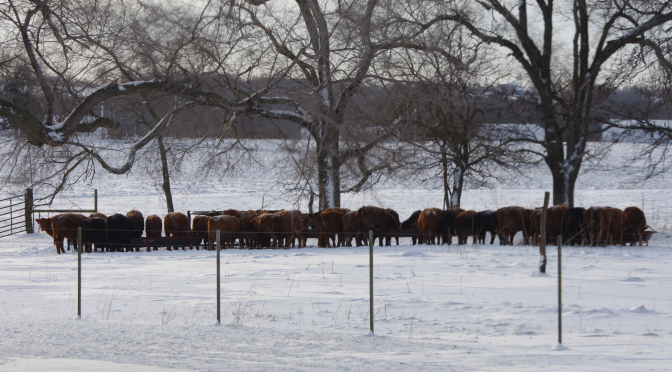So many variables need considering before deciding whether or not to feed calves through the winter – especially in super cold areas like ours in north Missouri. Profitability is very important, but it’s more than a dollars and cents decision; it also must include quality of life and harmony.
Consider reasons for feeding calves:
- weaning calves off young heifers early (before winter) so the pregnant young cow has time to recover before calving again in the spring.
- buying calves at a traditionally (late fall) lower price in hopes of adding value and gain before selling
- custom feeding calves and being paid by the owner
- Selling the cows and keeping calves.
In our case, the first and last ones are why we have calves this winter (2023-2024) to feed. With only 50 or so, I’ve decided to hand feed purchased alfalfa pellets in bunks which at the rate of about 1 lb per day, that’s quite doable. This gives them necessary added protein since our stockpiled forages through the winter is typically 7% to 9% protein. Good enough for cows, but not for growing calves.
I did go ahead and sell off about 12 calves that simply won’t match the others weaned or those still on the cows through the winter. They were smaller or rough haired and a few were steer calves showing a lot of Corriente – those will make excellent ropers since i left on the horns, but won’t match anything we will sell later in the spring or fall.
The cows were sold because i’ve planned to retire and lease out my farm since early last year. It takes time to organize that since i wanted to join cows with bulls much earlier than i typically do. Many producers want to calve in the winter, so to make the cows more desirable for that market, i did that. By weaning the calves earlier, selling the cows was easier since i didn’t have to mess with loading and hauling them. As it turned out, it seems the market in Dec and Jan would have been favorable to split the calves off anyway, so it was a good decision. Plus, i’m planning to keep as many replacement heifers as possible. (Wait! wasn’t i talking retirement? :-)) The steers will sell right with the calves weaned in April.
Since we sell only grass raised stockers and weaners, i chose to feed alfalfa pellets.
The downside is now it’s -14F and bitterly cold wind causing -37F windchill. Keeping the water open for another group of animals is very problematic as well in this weather. Typically, we do not have weaned calves, so we are not set up as well as we could be, so we’ll slog through this year.
Going forward, as we work through my husband’s health issues, me not wanting to work quite as much physically (trying not to break down my body), and rebuilding the herd as quickly as possible (or selling completely out and quitting), we need to decide whether or not to breed the heifers as yearlings or 2-year-olds. (Compare 2-year-olds vs 3-year-olds) An update on the previous link is that now i’m selecting ONLY my home raised, adapted cattle, the yearling heifers getting bred on grass is 67%.
There are plusses and minuses to each scenario. One of which is addressed here in having the added trouble of weaning calves early. It could be that once weaned, we could just go right ahead and sell the calves before winter, thereby eliminating feeding. However, should we decide to keep them and there were more calves to feed, we could purchase large bales of alfalfa hay to unroll which would be much easier than hand feeding in bunks. Also, address the watering issue!
Many options, we simply need to choose which direction we want to go.
Create something beautiful today!
Shalom,
tauna
For who of you desiring to build a tower does not first sit down and count the cost, whether he has the things to finish; that having laid a foundation, and not having strength to finish, all those seeing begin to mock him, saying, This man began to build and did not have strength to finish.” Luke 14:28-30 HRB


 All the fertilizer benefits from the bale-ring-fed hay are being deposited around the bale ring where the ground has been trampled into a mud slurry. Once the sod around the bale ring is pugged with deep holes through the sod, this area is guaranteed to grow a good healthy crop of weeds for years to come and it years to heal before it will ever grow grass again. Not only is it an eyesore on your pasture, it is no longer a productive area on the farm. If you have to feed hay to your animals, unroll it across the pasture to spread out the fertility.
All the fertilizer benefits from the bale-ring-fed hay are being deposited around the bale ring where the ground has been trampled into a mud slurry. Once the sod around the bale ring is pugged with deep holes through the sod, this area is guaranteed to grow a good healthy crop of weeds for years to come and it years to heal before it will ever grow grass again. Not only is it an eyesore on your pasture, it is no longer a productive area on the farm. If you have to feed hay to your animals, unroll it across the pasture to spread out the fertility.